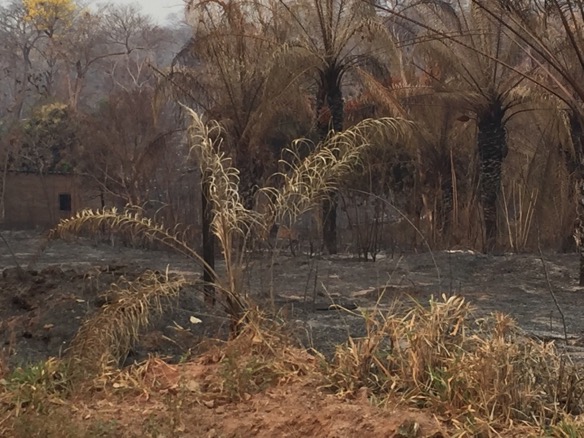My First Humanitarian Mission in Latin America 🇧🇴🇨🇴

At the end of August and the beginning of September 2019, I embarked on my first professional deployment in my role as the Rapid Response Coordinator for Latin America and the Caribbean (LAC). My mission took me to Bolivia, where I worked to coordinate the response to the devastating forest fires that were raging across the country. This deployment was particularly significant—not only because it was my first, but also because of the scale of the disaster and the importance of international cooperation in tackling it.
A Journey Through Bolivia
After a brief stopover in Bogotá, Colombia, I continued my journey to La Paz, Bolivia’s administrative capital. My time in La Paz was primarily dedicated to coordinating efforts with colleagues from the EU Delegation, preparing for the arrival of a French firefighting team deployed under the European Civil Protection Mechanism. Their mission was to support Bolivian authorities in extinguishing the fires and mitigating their spread.
Despite my busy schedule, I managed to take a short but unforgettable visit around La Paz, one of the most extraordinary cities I have ever seen.
La Paz: A City Like No Other
La Paz is not just a city—it is an experience. Nestled in a deep canyon at an altitude of over 3,600 meters (11,800 feet), it is one of the highest capitals in the world. The moment I stepped outside, I was struck by the dramatic topography. Towering above the city is the majestic Illimani Mountain, its snow-capped peaks providing a breathtaking contrast to the densely packed urban landscape below.
Unlike most cities, which expand outward, La Paz is built vertically. The wealthier districts, such as Zona Sur, sit lower in the valley, enjoying a milder climate, while the more modest neighbourhoods cling to the steep slopes of El Alto, the sprawling city above La Paz at 4,000 meters (13,000 feet). The views from above are spectacular—a labyrinth of red-brick houses, colonial churches, and modern skyscrapers blending into the rugged terrain.
One of the most unique features of La Paz is its teleférico system—a network of aerial cable cars that serve as public transport. Instead of underground metros or buses, locals glide silently above the city in colour-coded gondolas, offering unparalleled views of the Andean metropolis below. It was fascinating to experience this efficient and scenic mode of transport, which has become an essential part of daily life for thousands of Bolivians.
La Paz is also steeped in history and culture. As I walked through the Plaza Murillo, I admired the grand Government Palace and the Metropolitan Cathedral, both reminders of Bolivia’s colonial past. The city’s vibrant markets, particularly the Witches’ Market (Mercado de las Brujas), are filled with indigenous Aymara traditions, offering everything from herbal remedies to llama foetuses for spiritual rituals. The fusion of Spanish and indigenous influences makes La Paz a truly unique cultural hub.
The Devastating Forest Fires in Bolivia
After my brief time in La Paz, I flew to Santa Cruz, the country’s economic hub, and then travelled overland to San Ramón and Concepción, two of the worst-affected areas. The fires had ravaged over 5 million hectares of land, with smoke filling the air and turning the sky a haunting shade of grey.
Forest fires in Bolivia are a recurring environmental crisis, often caused by a mix of natural factors and human activity. The dry season, which lasts from May to October, creates the perfect conditions for wildfires, but much of the destruction is linked to slash-and-burn agriculture. Farmers and ranchers use fire to clear land for crops and cattle, a practice known as chaqueo. Unfortunately, during particularly dry years, these controlled burns spiral out of control, consuming vast areas of Chiquitano dry forests, Amazonian rainforest, and Gran Chaco woodlands.
In 2019, El Niño conditions exacerbated the drought, making the fires even more intense. The situation was worsened by deforestation policies and economic pressures, which encouraged agricultural expansion at the expense of the environment. The fires threatened biodiversity, including endangered species such as jaguars and giant anteaters, while also endangering indigenous communities who rely on these forests for their way of life.
The European Civil Protection Mechanism
One of the key elements of the response was the deployment of a French firefighting team under the European Union Civil Protection Mechanism (UCPM). This mechanism allows EU countries to pool resources and expertise to respond rapidly to natural disasters worldwide. In Bolivia, the French team worked alongside local firefighters, using their advanced equipment and expertise to help contain the blazes.
The coordination between Bolivian authorities, EU experts, and international teams was crucial in addressing the crisis. While the fires were ultimately controlled, the event served as a stark reminder of the urgent need for sustainable environmental policies and better disaster preparedness strategies to prevent such large-scale devastation in the future.
Reflections on the Mission
My time in Bolivia was intense and challenging, but also deeply meaningful. It was my first rapid response deployment, and it reinforced the importance of international cooperation in crisis situations. The destruction caused by the fires was heartbreaking, but seeing teams from different countries working together to protect communities and ecosystems was inspiring.
Bolivia’s stunning landscapes and rich cultural heritage remain etched in my memory. From the high-altitude wonders of La Paz to the scorched forests of Santa Cruz, it was a journey of contrasts—beauty and destruction, resilience and vulnerability. It was an experience that shaped my perspective on environmental disasters and the role of international aid, lessons that would stay with me in the years to come.
Click here to access the album.
